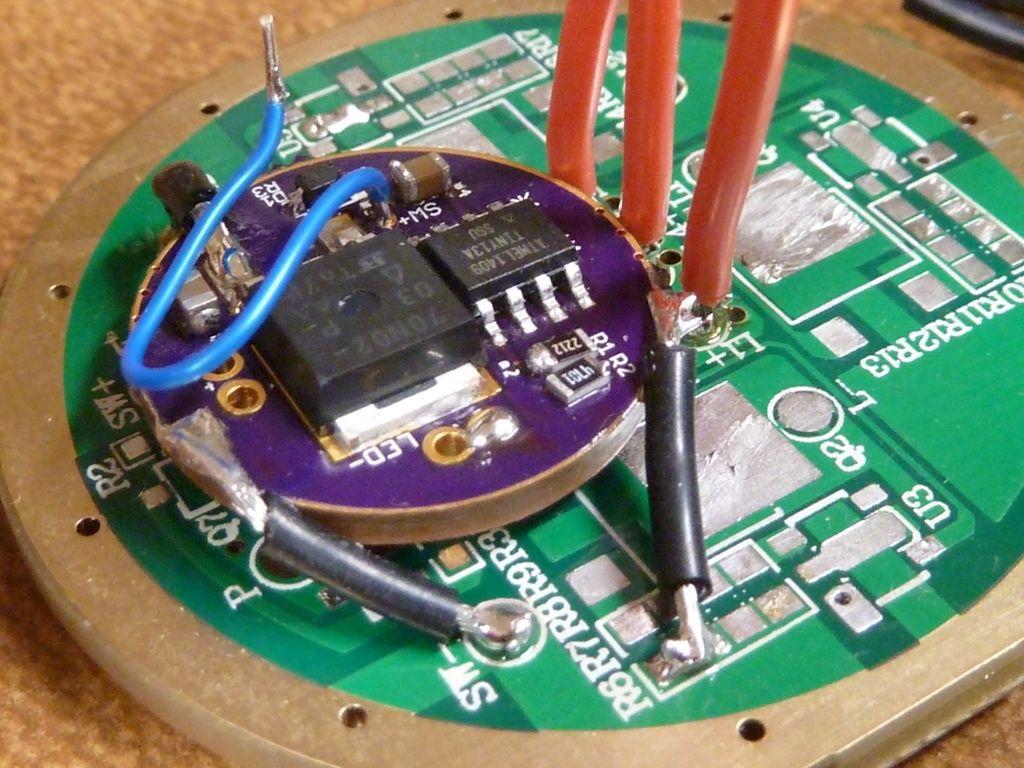Wow, all good suggestions! Thanks! Not sure if you are familiar with a typical SupFire M6 or SRK, but I'm using the stock M6 driver as a contact board (no driver springs at all), then piggybacking in the 22mm driver by using 3 short 22 AWG wires from batt- (ground) pads on the stock driver, then soldered to the 22mm driver's ground ring - so I feel the ground connection is pretty good.
For batt+ to the LED's, the 3P LED's are wired direct to pads on the stock driver using 20 AWG wire - wires must be little longer to accommodate access to the screw that holds down the reflector (like all SRK's pretty much). For batt+ to the driver, a short 24 AWG wire from a pad on the stock driver to the spring pad of the 22mm driver. For LED-, 3 20 AWG wires to the one single LED- pad on the 22mm driver. I think this is all pretty much a standard setup for SRK style lights. You really don't want to replace the stock M6 driver because the batt+ ring is super thick and I don't think any OSHPark board can be near the quality of that setup.
- Didn't try the brownout enabling -- will do!
- also I got a bunch of 0.1 uF caps today at work, so will try that as well.
- could try the resistor
Also I got a couple of bigger wired lead caps to try in place of the two 10's I got in there now (suggested by an EE at work).
I'm think'n we are on the right track because maybe the 25/45/85's are just a bit more sensitive to the large amp switching than the 13A?
Update:
First did the brownout 1.8v enable, and it still flaked out the same way - weird blinking, etc.
Then tried a big leaded cap -- got it working with a 47 uF leaded cap on the zener pad (with 2 10 uF caps left on the C1 pad). Removed 1 of the 10 uF caps, and it still worked. The cap I'm using is an old style - 47 uF 50V rated, big cylindrical shape. I can use it in my SupFire M6, but obviously won't work in triple/quad tube lights, and similar 17mm driver lights.
Been trying to revert back to brownout disabled, and revert back to FAST PWM, but my ASUS Win10 locked up, and after power reset, it's loading Win Updates now - great.... I think finding small package caps at larger values is not easy, maybe impossible?
Update #2:
Got the M6 assembled and doin some testing. So far so good. No brownout now, FAST PWM mode. 5000 lumens, almost as good as it was all newly modded. Real nice having the lockout capability.
Got in a Sunwayman C20C today from Illumn - wow, real easy to mod and great deal at $30 (1/2 price) - got it all torn down now. Might be tight fitting in a 17mm piggyback style. Stock driver is about 20 mm. It's a similar style to a Roche F6 but different - much lighter, little smaller. Nother great candidate for an 85 e-switch. Has a shallow reflector, so may also be a good candidate for a triple, in which case this problem needs further addressing for a 17 mm driver.
 .
.
